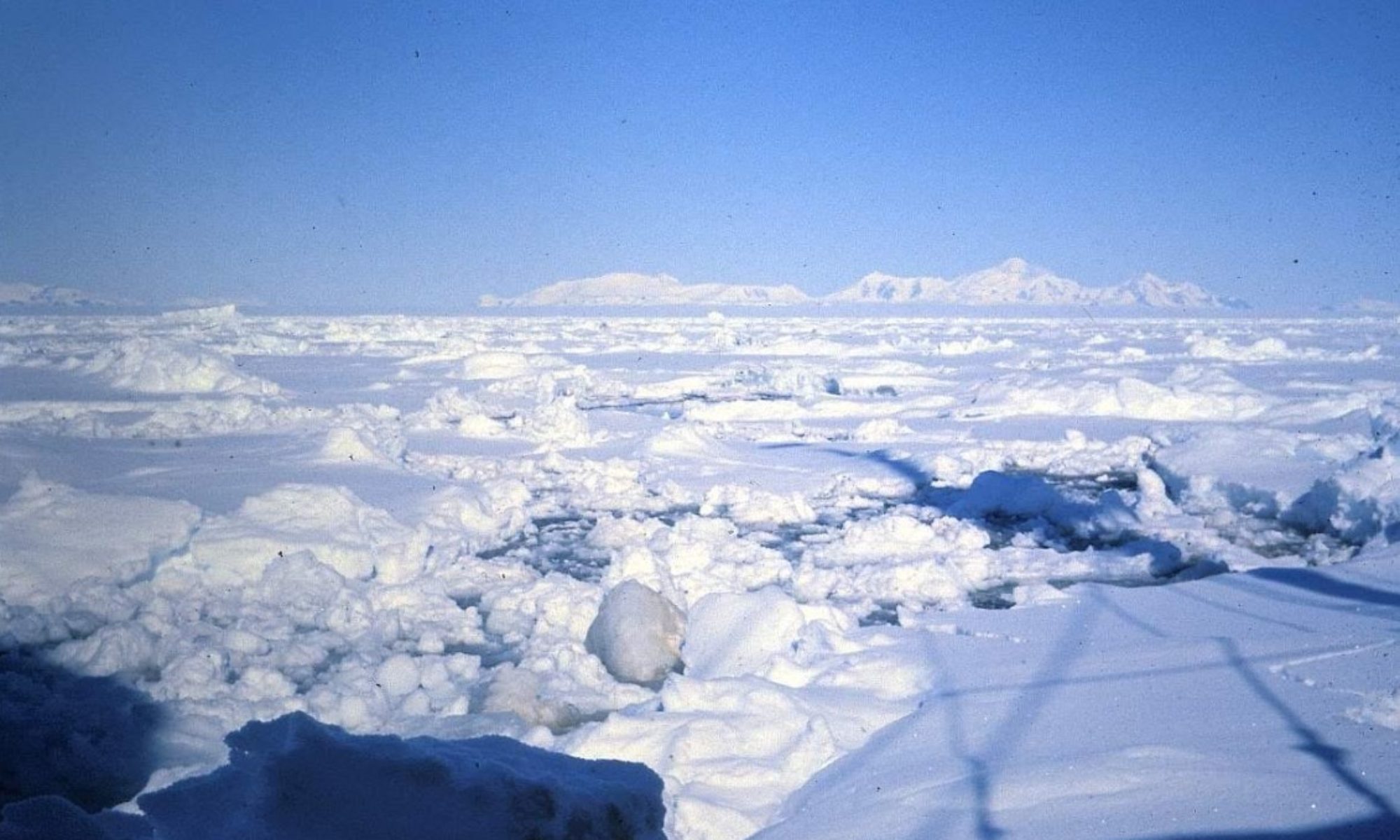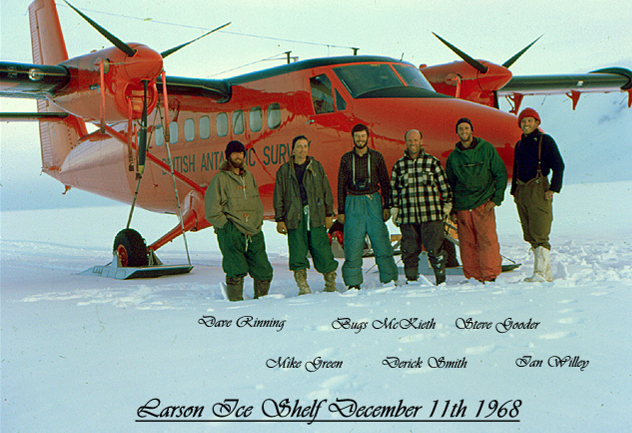
When the Twin-Otter set off from Adelaide, the mission was to relieve a 5-man party that had been stranded and over-wintered at Fossil Bluff where there was a 4-man hut, around 300 miles to the south in King George VI Sound.
At that time, the BAS bases in Marguerite Bay had primitive and unreliable radio beacons, there was no such thing as GPS and navigation was largely based on visual recognition of major features using relatively sketchy maps. The pilot, RAF Squadron Leader Derek Smith was new to BAS, new to the environment and new to the planned flight path – one that required flying south over the partly frozen seas of Marguerite Bay, followed by navigation over the shelf-ice of King George VI Sound, close to the alpine-scale peaks of Alexander Island.

The locating and rescue of Alpha Oscar was to take eleven, very stressful days, for the Twin did not get back to Adelaide until 20th December. Meanwhile, recovering the situation (rescue?) had called upon all the resources that BAS could muster, including London office; Port Stanley Office, the BAS bases; “RRS Shackleton”; “RRS John Biscoe”; the Royal Navy’s the ice patrol ship “HMS Endurance” and the Argentine bases on the peninsula.
This is an account of that incident, pulled together over 50 years on, using a variety of resources that include the recollections of Ian Willey and Dave Rinning, both of whom were on the aircraft when it made its forced-landing…
Setting the Scene
A key feature of the incident is that there was too much “pressure” in the system for the flight to take place, so the story really starts with an account of what created the pressure …
On 26th February 1968, the BAS single-engine Pilatus Porter piloted by RAF pilot John Ayers landed on the Grahamland Plateau at the junction of the Millet and Meikeljohn glaciers in order to pick up a geological field party consisting of Rod Ledingham and Graham Smith with their team of 8 dogs. During the subsequent take-off, an under-carriage weld failed, causing a ski to turn outwards, and in bringing the slewing aircraft under control, the tail ski was torn off – damage that could not be repaired in the field.
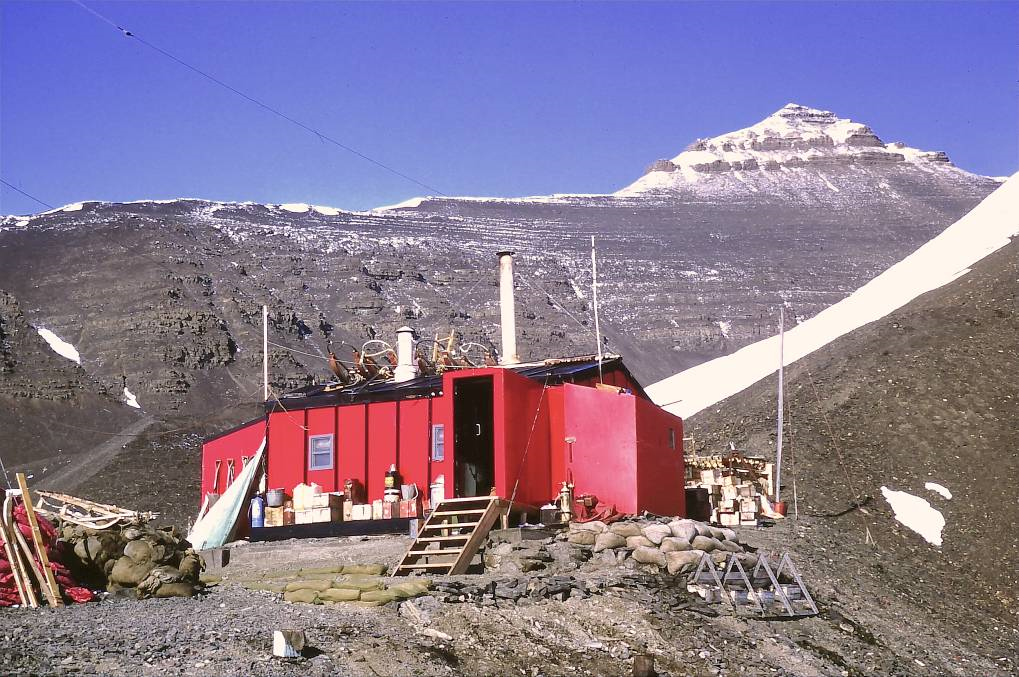
However, John Ayers assessed that with skis removed, the crusted surface might allow a take-off on wheels, and this nearly suceeded until a wheel broke through the crust, tipping the plane onto its nose and bending all three propellor blades. Having secured the Porter as best as they could in the hope that parts could be salvaged at some future time, the 3 men and dog team sledged 130 miles to reach Fossil Bluff, including a crossing of the waterlogged King George VI Sound.
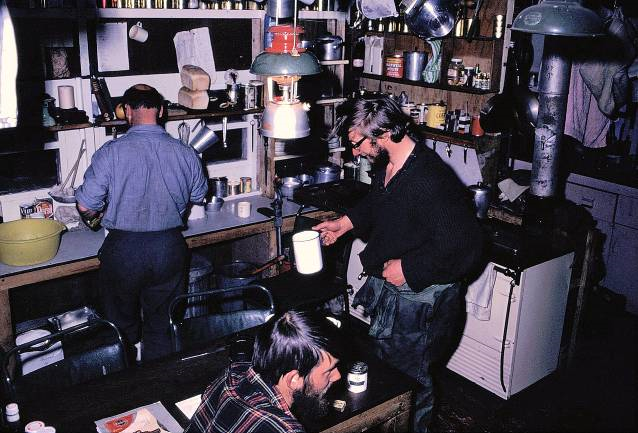
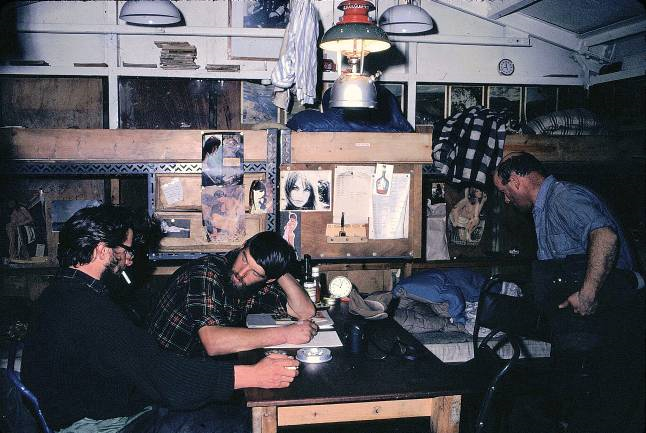
There was now a compliment of 5 men at Fossil Bluff, and they would now have to survive the winter in a hut designed for 4 men.
The team wintering at the Bluff was Martyn Bramwell (Adelaide met); Rod Ledingham (Adelaide met) John Walsh (RAF Air mechanic); Graham Smith (geologist) and John Ayers (RAF pilot) and they were destined to have an uncomfortable winter, requiring them to take turns in sleeping on the floor. On one occasion Martyn woke up to find that his head was frozen to the floor. From a BAS perspective it was clearly advisable to extract the marooned team as soon as possible, and with this in mind, Alistair McArthur (Base Commander Stonington) decided to mount a rescue bid with dog teams as soon as Spring weather would permit.
On September 19th 1968, 3 dog teams with Alistair, Sean Norman, Ian Flavell Smith and Lew Willey set out from Stonington to reach Fossil Bluff. But the weather was foul and progress slow. With the sea-ice breaking up they were also running low on food and fuel. They were in serious trouble. After some hair-raising adventures that make a great story in their own right, the party retreated to Stonington, now supported by additional Stonington dog teams.
It should therefore be no surprise that by December 1968 and the arrival of the new flying season, the extraction of the Fossil Bluff wintering party had come become the Adelaide aircraft’s first priority – a pressure in its own right.
Sources of this account
Flying operations in Marguerite Bay in 1968 were managed by Alistair McArthur, Base Commander Stonington and Alistair was closely involved throughout the incident, keeping a detailed, blow by blow incident log of all that happened.
Surprisingly, Alistair was never asked to submit a formal report to BAS office. The oficial, BAS Air Party Report for December 69 – March 69 written by Derek Smith provides no detail whatsoever for the period of the incident. However, in 2013, using 60 pages of his original, hand-written notes, Alistair produced a 14 page description of the incident, which along with Sir Vivian Fuch’s version of events described on pages 301-302 of his book “Of Ice and Men” (published by Anthony Nelson 1982) are the nearest we can get to having an official version of the story.
What makes the story even more intriguing is that there are very interesting inconsistencies and discrepancies between these accounts, as well as with the recollections of two, first-hand participants – Ian Willey and Dave Rinning.
Sir Vivian’s “Of Ice and Men” pages 301-302
…“With the return of the ships in October the crated Otter was picked up from South Georgia and landed at Deception, where it was assembled, tested and flown south to Adelaide by Flight Sergeant Mike Green. We also brought into service our first twin-engined aeroplane, a de Havilland Series 200 Twin-Otter, built on the same sturdy lines as its single-engine forerunner. Since it was not practical to ship so large a plane to Deception, Squadron Leader Derek Smith flew it from Toronto down the length of the Americas, and finally across the Drake Passage to Adelaide.
His first task on arrival was to carry eight men and a cargo of rations to Fossil Bluff. He was newly arrived, unacquainted with the terrain, and with no experience of the rapid weather changes which are such a feature of the area. When almost at his destination he received a report that the local conditions there were deteriorating and landing would be hazardous. He decided to return to Adelaide.
By now the plane was flying above a blanket of cloud through which only one or two mountains stood clear. Smith misidentified one of these as Mount Edgell near Cape Jeremy, which led him to believe that he was off course. Since he was not receiving the homing beacon at Adelaide, he adjusted course in relation to the mountains he thought he had recognised.
Time passed and still he flew above impenetrable cloud, until there was only half-an-hour’s fuel left. He radioed base saying that he had to land to await clearer conditions. Coming down the plane broke cloud at 400 feet and Smith reported crossing a wide chasm in the ice below, but he still thought he was over sea ice on the west side of the peninsula. A few minutes later he landed, but in the poor visibility no features could be seen.
Assessing their resources, they had 30 days’ food, but by an oversight there was no stove, and the only fuel was in the aircraft’s tanks – which the pilot rightly decreed must be reserved for the flight out. There were only two sleeping bags between nine men. The outlook, while not dangerous, was distinctly bleak and uncomfortable. The party settled down to a routine which included a few hours each in a sleeping bag, cold uncooked food and ice cold water to drink. This they obtained by hanging plastic bags filled with snow inside the plane, where it melted under the sun’s radiant warmth through the glass ports.

Meanwhile, we were all trying to decide exactly where the plane was. It was three days before the weather cleared sufficiently for Smith to report that he could see mountains to the northwest, perhaps seventy miles away. Meanwhile Biscoe and HMS Endurance had been alerted, and both were sailing south while taking bearings on Smith’s periodical radio transmissions. These indicated a rough position in the vicinity of Joerg Peninsula on the east side of the Antarctic Peninsula, and therefore too far for the plane to fly back to Adelaide on the available fuel. They had indeed been lucky not to be over the high mountainous peninsula when descending through the loud cover.
A search of the records at home revealed that there was an old depot containing food and some fuel at Three Slice Nunatak, some twenty miles from where they had landed. Hearing this, Smith used some of his precious fuel to fly there but failed to find the depot, presumably now buried by several years of snow accumulation.
Somehow fuel had to be got to the marooned party, over the intervening 5,000-foot peninsula. To do this with the dog teams would have taken several weeks, so naval helicopters were an obvious answer – but Endurance could not penetrate the ice lying to the west of Adelaide. Captain Peter Buchanan agreed to fly both his helicopters to Adelaide and from there to Stonington, whence they would try to cross over the mountains to the east coast.
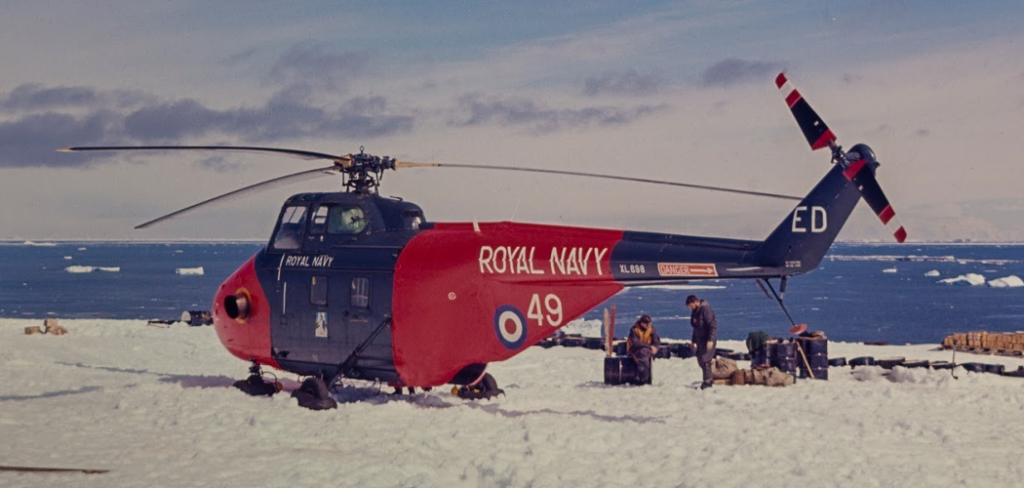
(Photo: Bill Taylor)
Such a flight would be hazardous because of the unlikelihood of good weather on both sides of the peninsula at the same time and, anyway, helicopters have their limitations. When heavily loaded their ceiling was barely sufficient to clear the mountains, and their rotors were very liable to ice-up in cold cloud. Four times they took off from Stonington, and four times were forced to return.
On the thirteenth day after the Twin-Otter had forced-landed they at last managed to bring in a load of extra fuel – just as the weather was once more deteriorating. As quickly as men could move it was transferred, Smith took off with all speed, and the three aircraft returned safely to Adelaide. Owing to the determination and skill of the naval pilots, no one was any the worse for their ordeal – just a little thinner, and with memories of cold uncomfortable days sufficient to prevent any future forgetfulness in stocking a plane with emergency supplies.” ….
Alistair McArthur’s 2013 document
BT comment:
- As Base Commander, Stonington 1967 and 1968, Alistair McArthur had overall responsibility for aircraft operations from Adelaide, Stonington and Fossil Bluff.
- In mid-December 1968, Alistair spent a great deal of his time on the radio in helping to manage the “Twin Otter Incident”.
- Alistair was surprised that no official report was requested by BAS regarding this very serious incident.
Alistair’s Incident summary:
- In November 1968, a new British Antarctic Survey Twin Otter flew from Canada to Adelaide Island (Base ‘T’ – British Antarctic Survey – Latitude 67degrees 46 minutes South; Longitude 68 degrees, 55 minutes West).
- The Twin’s first mission was to relieve the 5-man party that had been stranded and over-wintered at Fossil Bluff and on 10 th December 1968, Derek planned to fly from Adelaide to Fossil Bluff (Base “KG”, Latitude 7120 S; Longitude 6817 W).
- The flight required clear weather at both bases because there were no reliable radio beacons i.e. the flight path relied on visual fixes. Base metmen concluded that from their local knowledge the flying conditions were the wrong side of marginal, while the aircrew were pushing to go ahead and took the decision that a flight was on.
- There were 6 personnel on the flight:
- Squadron Leader Derek Smith RAF (Pilot);
- Flight Lieutenant Mick Green RAF; (Co-Pilot);
- Corporal Steve Gooda RAF (Aircraft Mechanic);
- Ian M. Willey (B.A.S. Meteorologist, Adelaide and BC designate 1969);
- Alistair “Bugs” McKeith (BAS GA Adelaide);
- Dave Rinning (BAS GA Tractor Mechanic, Adelaide).
- The Twin Otter failed to get below the cloud and the flight crew failed to recognise the mountains that came into view during cloud breaks. Consequently the twin was flying blind and eventually ran low on fuel. Almost 5.5 hours later, with only half an hour’s fuel left, the Twin carried out an emergency landing in an unknown position on an iceshelf, later to be identified as the Larsen i.e.on the east Coast of the Antarctic Peninsula. Lack of fuel precluded the possibility of a return flight to Adelaide Island for 11 days.
- BAS ships, the BAS bases and HMS Endurance (at that time cruising off South Georgia) eventually got a radio fix to triangulate the position of the aircraft. Endurance sailed south as far as sea-ice would permit in order to use her helicopters to depot 40-gallon fuel drums towards the downed aircraft.
- Two Royal Navy helicopters from HMS Endurance established themselves at Stonington before weather was clear on both coasts. A key member of the Royal Navy aircrew was Mike “Beest” Rufus. HMS Endurance Captain Peter Buchanan assisted greatly with logistics.
- Two Royal Navy helicopters from HMS Endurance flew from Stonington Island to the Twin Otter marooned two miles west of Three Slice Nunatak(Latitude 6802 S; Longitude 6457 W). The helicopters carried 40-gallon drums of much needed fuel for the Twin Otter. Flying over the Antarctic Peninsula from the west coast to the east coast and return proved to be a hazardous exercise.
- Assisting at Stonington Island (Base ‘E’) were Chris Madders (Radio Operator), Shaun Norman (G.A.; Base Commander designate 1969; Lawrence Willey (Geologist) and other 1968 Base “E” wintering personnel.
Stonington Radio log for 10.12.68 re Bluff Flight
1305z Twin-Otter Alpha Oscar departs Adelaide Island bound for Fossil Bluff
1440 ETA at FB in 10 minutes i.e.at 1450
1500 Conclusion that AO is over plateau
1510 AO flying west – uncertain of position
1520 AO flying further west for 10 minutes. If no sighting of ‘Sound then turning north for Adelaide
1530 AO now returning to Adelaide – still no idea of position
1555 AO flying course of 340 degrees
1730 AO still in cloud and uncertain of position
1737 Flying at 6,500 feet in “mank” i.e. thick cloud and decide to come down to fix position.
1743 3,500 feet in “mank”
1747 2,000 feet descending in cloud
1804 Sea level in fog heading South East. One hour fuel left
1808 Decision to head East for half hour but will have to land
1830 Landed. No further Radio Transmission. All personnel OK.
Behind these two accounts are plenty of human interest stories… Taking the recollections of Ian Willey and Dave Rinning into account, the story comes out as follows.
Adelaide airletter 21 implies that the Twin-Otter arrived at Adelaide for the summer season 68/69 on 4th December and was piloted by RAF Squadron Leader Derek Smith, who had flown the plane from Toronto via the Americas and across the Drake Passage to the Antarctic Peninsula. To quote Fuch’s “Of Ice and Men”, he assesses Smith as follows:
“He was newly arrived, unacquainted with the terrain, and with no experience of the rapid weather changes which are such a feature of the area.”
RAF Air Mechanic John Walsh (who had wintered at the Bluff in 1968) knew of Derek because Smith was one of the RAF survival school instructors.
Flight mission
Were it not for the 5-man unplanned winter at Fossil Bluff, the aircraft’s flights would be those agreed with Base Commander Stonington and base Commander Adelaide. However, there was no question that the Twin’s first priority was to replace the men at the Bluff and this was a very important factor in creating pressure to make the flight.
The flight from Adelaide to relieve Fossil Bluff included the following 6 (not 9 as recorded by Fuchs) personnel:
Derek Smith (RAF Pilot); Mike Green (RAF co-Pilot); Steve Gooda (RAF Air mechanic); Ian Willey (Metman to replace Martyn Bramwell); Alistair “Bugs” McKeith (GA); Dave Rinning (GA Tractor mechanic).
Apart from essential supplies, the pay-load would include special treats for the Bluff men and emergency survival kit – personal bags containing spare clothing and sleeping bags for each member of the flight, plus a small sledge, climbing rope, skis, a pup tent, rubber dinghy, prismatic compass, a Primus or Optimus paraffin stove, fuel for the stove and emergency food rations.
Ian Willey (as BC designate for 1969) recollects with confidence that the requirement to follow the above protocol was fully explained to the newly arrived aircrew by Don Parnell, 1968 Base Commander Adelaide.
Ian Willey:” Briefing was carried out by Don Parnell, he was BC and this was his second trip South … Also the need to heed the Base Commander instructions re weather etc.
The Decision to Fly
Given Smith’s lack of relevant experience, the decision as to whether conditions were suitable to fly or not should have been guided by the local knowledge of the base Metmen – Ian Willey and Brian Sheldon at Adelaide, Martyn Bramwell and Rod Ledingham at Fossil Bluff.
By 10th December, the poor weather conditions that had precluded flying had started to improve. However, the reality was (and is) that pilots were pushing to “go for it” (and pilots are well versed in observing and understanding “weather”) while the BAS metmen thought the conditions were still the wrong side of marginal. Smith (at Adelaide) was probably very keen to carry out his first proper mission and Ayers was more than keen to escape from the Bluff – making him very pushy in putting a rosy complexion on describing weather conditions that were probably less than marginal.
Ian Willey: … “Larsen was a complete foul up from the start. Weather at Adelaide was very poor not flying weather at all. Martyn’s report from the Bluff was marginal at best. Smith contacted Ayres (whom he knew well as they had worked together in the RAF) and came back with a much improved met report from Ayres”
Take off – 10th December
The aircrew packed the plane in accordance with the protocols already described.
Ian Willey: “… Don Parnell arranged the three P (personal) Bags and sent the emergency gear to the plane -Tent, small sledge ,sledging box content was displayed rope emergency rations and fuel etc. it was also explained the high importance of this equipment to be carried on all flights.”
The Twin-Otter headed downhill on the glacial runway, made two attempts to take off, each time failing to get sufficient lift to become air-born.
Smith decided that the payload would have to be reduced, and without the presence of the base personnel, repacked the load, discarding such items as he thought necessary and making a profoundly flawed judgement regarding the safety and emergency kit, most of which was discarded, including skis, stove, fuel, pup tent, food etc.
Ian Willey: … “All was ignored. The three base personnel were loaded in the back of the aircraft and unable to see the items unloaded prior to eventual take off …The Primus and the emergency pup tent and the air crew P bags had all been ejected from the Aircraft at Adelaide”.
On this, the third take-off attempt, at 1305z Alpha Oscar managed to take off and headed south in thick cloud.
Ian Willey: “It was only on the third attempt that he was able to get the Twin Otter off the ground.”
The Flight
The flying conditions were so poor that they could not get below the cloud. Consequently, the navigators never got a reliable visual fix on easily identified land features, so could not estimate the effects of any cross-wind – and were therefore flying blind. The details of the flight communications and timings of when decisions were taken can be seen in the Stonington Radio log.
Ian Willey: “When we departed Adelaide the cloud covering was low mank (i.e. thick cloud). We climbed to approximately 10,000 feet and flew towards the Bluff.”
Rod Ledingham was the metman at the Bluff and provided his diary notes to Ali McArthur for the latter’s 2013 document. Rod stated:
“I had done a pilot balloon and reported to them that the wind was westerly at about 70 knots at 10,000’ feet”
This statement infers that the weather at Fossil Bluff included a relatively high cloud base or the low and medium cloud was very broken – otherwise Rod could not have sent up a pilot balloon.
Ian Sykes (Stonington GA): “On the day the Twin Otter flew to the Bluff, an unseen aircraft was heard to fly over the base, causing a scramble to activate the radio beacon because the base had not been alerted to the flight.”
This must have been on the outward flight from Adelaide, and unless they were going to use the west coast as a navigational hand-rail, is way too far west for a flight to Fossil Bluff.
Ian Willey: “We made the trip South inside the cloud, so he (Smith) had no measure of effect of the wind on our course. When we got far enough South (i.e. where we should be near the Bluff) I was called up front and the question was asked, “what elevation is the Sound?” My reply, “sea level” was received with looks of concern. We were surrounded by mountains, so flew back up into the clouds to return to Adelaide … We flew South in cloud for the complete journey and only saw anything when we descended to look for the Sound entrance and the Bluff. Nothing but Mountains”.
The repeated attempts to find the Bluff – and then Adelaide – resulted in getting low on fuel and a scary, blind landing at 1830z that was hopefully in the Sound or on the Plateau, but it could have been anywhere and was in fact on the wrong side of the Peninsula i.e. the Larsen Ice Shelf on the east coast of the peninsula.
How could this be? It can only be accounted for by a cocktail of serious navigational errors and the factors that led to this are worthy of further consideration.

Dave Rowley, as an experienced civilian pilot who took over the piloting of the Twin-Otter for the summer of 1969-70, then went on to serve BAS in that capacity for five seasons. It is Dave’s opinion that flying blind, with no reliable radio beacon using dead-reckoning navigation was never a realistic option. There was no way of accurately assessing the crosswind factor – almost certainly a strong westerly on the day, and over an area where in 1968 the magnetic variation of the peninsula was anything between 10 and 30 degrees. Dave points out that even a single degree of compass error over a flight of 60 miles produces a mistake on the ground of one mile. Apply similar reasoning to Alpha Oscar’s possible flight path on 10th December and the Larsen landing is easily accounted for.
Ian Willey: …” How we crossed the peninsula and managed to land was, in my opinion, blind luck.”
The full extent of the breach of emergency kit protocols was only apparent once they had landed on the Larsen, and this is where the Vivian Fuchs version of events gives a very wrong impression, for the absence of the emergency kit was definitely not a case of forgetful oversight (as suggested by Fuchs), but a calculated and unacceptable decision of the aircrew and the direct responsibility of the pilot.
Ian Willey: “To the best of my knowledge we loaded three pairs of short skies for use with dogs but they were not on the aircraft on the Larsen.” (the McArthur account says there was one pair of skis)
Since they did not know where they were, the next day, when the weather showed a slight improvement, the aircraft’s location was the subject of discussion.
Dave Rinning: …“ I recall flying south and the comments that came from the flight deck that they were unable to find FB and would turn back to Adelaide. As we flew north again, I remember at one point sitting on the port side looking out of the aircraft window as we flew over broken sea ice and thinking it was not going to be fun if we had to go down into that terrain.
After prolonged attempts to find Adelaide proved fruitless, Smithy ultimately declared there was little fuel left (30 minutes) and we would have to go down. It seems we made a long, slow, spiralling descent and at some point the surface loomed up and we made a satisfactory landing in very poor visibility. I do not recall being overly afraid under the circumstances, but there must have been some anxiety involved.
After we landed and jumped out of the aircraft, I recall Ian, Bugs and I concluded we must be on shelf ice, based on our experience of the composition of the snow and the flat nature of the terrain. There was little visibility at that time, so we had no idea of our immediate surroundings. None of the group had any idea of our location.
Ian Willey: … “When we informed our captain (Derek) we were on the Larsen he had a big discussion that if it was shelf it could only be the Wordie, because he had not flown at an altitude to cross the peninsula. But when we were able to show him Cape Agassiz on the map he went very quiet.”
Dave Rinning provides some graphic details of the days on the Larsen. Once again, there is some discrepancy with the Fuchs version. e.g. Dave and Ian Willey assert there were 4 sleeping bags to share. e.g. Fuchs says there was 30 days food (3 boxes of man-food) – backed by the Stonington radio log, while Dave Rinning says 1 box of meat bar and dried peas.
Dave Rinning: “We took stock of
what we had in the aircraft the first day, and I recall we had a box of meat
bar and cans of dried peas. That was it for the food, except for my Dundee
cake, which I was reserving for Christmas. We had a case of beer on board and I
remember drinking one because I wanted to use the can to melt snow. I took the
can with snow into my sleeping bag, but the amount of water produced was
minimal, since there was little enough heat to melt it. Water was to be an
issue till we came up with a solution.
There was no stove and no fuel, and I recall we speculated at one point if
there was some way to use Avgas as a source of heat, but nothing ever came of
this and we abandoned thoughts of heat.
Using the aircraft radio, we were able to hear r/t transmissions from either Adelaide or Stonington. The base could not hear our r/t responses but they let us know they could hear the click of our microphone button as we attempted to communicate. Don Parnell our radio operator had taught me how to key Morse code and I was able to relieve him periodically and send the weather obs to Port Stanley. Using the microphone button as a Morse key, I was able to communicate from the aircraft and give base a regular update on our status and describe our weather conditions. Regular scheds were established and base soon worked out a system wherein they asked us a series of questions to which we only had to answer yes or no, using 1 or 2 microphone key clicks. That helped us conserve battery power. At one point Smithy became concerned about the state of the aircraft batteries and he started the engine(s) to do a recharge.
Re Dave’s contribution to radio communication, Ian Willey stated:
…”without Dave’s skills utilizing the aircraft radio to transmit via Morse code to Stonington we would all still be on the East coast”.
Dave Rinning: Life inside the
aircraft settled into something of a routine. For the first several days the
mank persisted and we had no sense of our surroundings. Ian Bugs and I had our
P Bags with us and we had 4 sleeping bags, which meant 2 had to remain up,
while the others were resting.
Included in the cargo on the aircraft was a large black plastic rubbish bin
bound for FB and we threw that into the cockpit to get it out of the way. Ian
and I would spend our non-sleeping time in the cockpit, and at some point Ian
observed that the UV coming through the aircraft windows was causing the rubbish
bin to warm up. We loaded some snow into the bin, and with time it melted, and
with more time we were able to generate enough water for our overall needs. Using
water from the bin, we reconstituted meat bars and dried peas, which served as
the basis of our daily meals for the duration of the stay. (I carved a spoon to
eat with from the wooden box, which I still have with me today).
After a few days on the ground the weather cleared and we were able to observe
a large mountain range to the one side of us. Observing the location of the sun
in relation to the aircraft and the mountains, we concluded with some surprise
that we must be on the east side of the Peninsula. I don’t recall if we had
charts on board or if our location was pinpointed in coordination with
discussions with base, but we soon established a reasonably accurate fix on our
location, on the Larsen Ice Shelf.
In the course of the following days we had word from London that a depot had
been established many years earlier at Three Slice Nunatak some miles off…
Smith flew the aircraft a short hop to Three Slice Nunatak to try and locate the depot.
Dave Rinning: ….Ian, Bugs and I set out to find the depot, and while we were somewhat confident that we were in the correct vicinity …We were at the 3 Slice Nunatak and digging about in the high spots, the logical places to find a depot, but we never found anything… We found out later that it had been removed.
It was unclear in those days what the outcome of our fate might be. It was not certain at the time that there might be an outside solution to our predicament and there was discussion among Ian, Bugs and I that we might have to walk out. I believe we concluded that we could cross the mountain range if it became necessary. The reality was that only the three of us had the necessary clothing to make the attempt, while the three flight crew were wholly unequipped for such a journey.
Meanwhile, while all of this was going on, we had no idea at the time that HMS Endurance was at South G, with Pete Rowe ashore doing geological field work. Captain Buchanan received orders to collect Rowe and head in the direction of Adelaide.”
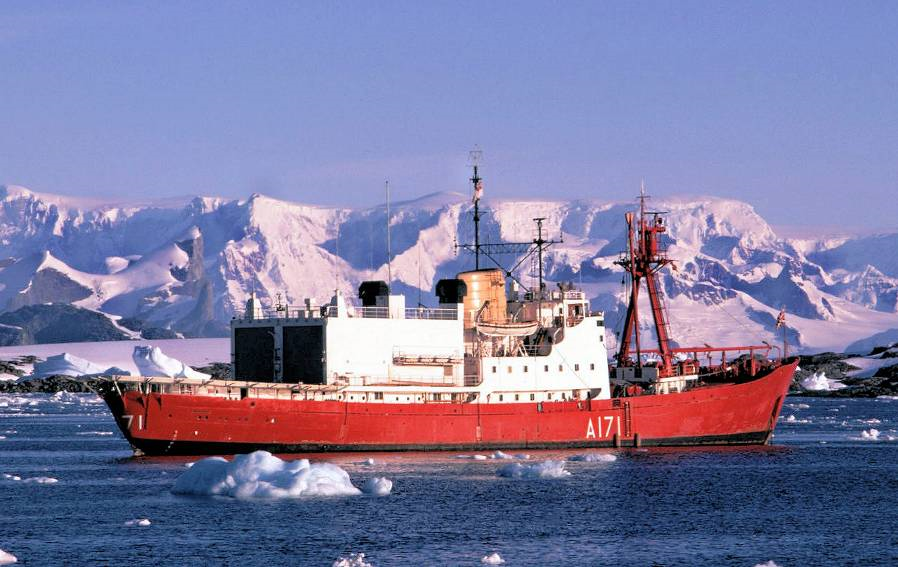
Endurance’ attempt
to reach Adelaide and use its two helicopters to depot-hop 2 drums of fuel to
the Larsen via Stonington was initially thwarted by pack ice off the west coast
of Adelaide, so the helicopters (with a range of 140 miles) flew on to
Adelaide, refuelled, then stocked Stonington. The Twin needed a minimum of
500lbs of fuel to get from Three Slice Nunatak to Stonington.
Dave
Rinning: …”Once it came within striking distance of Adelaide, and the limits of
the fast ice, the Endurance had its helicopters start laying fuel depots in
order to get within range of base and our location. There was an initial
attempt to reach us as the helicopters crossed the mountain range from Stonington.
However, the cloud layer prevented them from descending that day and we could
hear them turn back.”

The following day was clear and the helicopters returned, dropped two drums of fuel and a hand pump, gave us some cans of self- heating soup, and quickly went on their way. This must have been about day 14 or 15 (More probably 8 or 9) after we made the forced landing.
Ian Willey: “ On a lighter side, because it looked as if we were to spend Christmas on the Larsen, it was agreed we would save Dave’s Dundee cake for Christmas Day and to provide some light entertainment, Dave made a nightly recital of the merits and content of the Dundee cake and its historical impact on Scottish history”
Dave Rinning: After we had fuelled the aircraft Smithy fired it up and we started our take-off run. I remember it had warmed up by this time and the surface was really sticky and it took us a long time to get off the ground, but we were finally in the air and it seemed no time at all till we were back on the piedmont at Adelaide”.
The Twin was still low on fuel, so the flight plan was to fly to Adelaide via Stonington. But once again, the flight did not run to plan …
Ian Willey: …”The saga continued. Having been refuelled by the timely arrival of the choppers, Smith decided to overfly Stonners and head for Adelaide”
London office was never happy with a plan that required the twin to land on the NE Glacier. The Twin landed safely at Adelaide at 2005 on 20th December.
Ian Willey: Again short of fuel …… but our flight plan changed … the flight back to Adelaide was another close run thing. Initially, we were to land on the North East Glacier at Stonington to take on more fuel, but it was only when I saw the base members waiting on the NE runway that I realized we were in fact heading to Adelaide …. we flew direct to Adelaide … with our Dundee cake still in one piece – … a major factor in maintaining morale…
